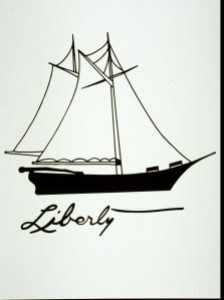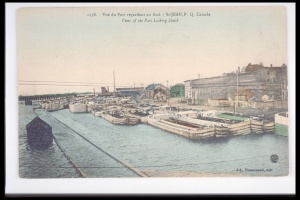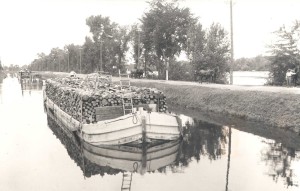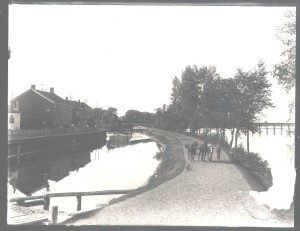by Art Cohn
The Bicentennial tour, 1812: Commemorating the War: Celebrating the Peace continued north from Isle aux Noix to Saint-Jean-sur-Richelieu. Saint Jean is a community whose strategic location at the northern end of Lake Champlain-Richelieu River navigation corridor has connected us together in history. I first studied this historic place in conjunction with Ethan Allen and Benedict Arnold’s taking of Fort Ticonderoga in May of 1775.

After Arnold realized he could not safely remain amongst the Green Mountain Boys he had alienated, he was able to make his exit aboard the schooner just arrived from Skenesborough, present day Whitehall, NY. The schooner had belonged to Philip Skene and had been captured by a rebel force that while enroute to Ticonderoga had re-christened it Liberty. I have always thought that was a profound reflection of the moment and the times. Arnold, now comfortably aboard, set sail for Saint Jean and successfully surprised and captured the only other large vessel in the watershed, the King’s sloop, which he re-christened Enterprise. Arnold accurately reports to Congress that with the capture of these two vessels, “We are Masters of Lake Champlain,” and both Arnold and Allen advocate that the Champlain-Richelieu corridor should now be used for an invasion of British Canada. Our visits to Isle aux Noix, Saint Jean, Chambly, Sorel and Montreal directly reflect on this important chapter in our shared national stories.

Flashing forward some 236 years, our visit to the Royal Military College at Saint Jean was in sharp contrast to the violent siege American forces waged in 1775. In 2012, our crew, bringing the gift of history, was accorded the warmth and hospitality of rooms, meals and showers to help support us in our mission to recall the shared story of the War of 1812 and the canal era that flowed from it. Our reception at Saint Jean gives further credence to this year’s theme of “Commemorating the War and Celebrating the Peace.” The Saint Jean community could not have been more gracious of our visit. Our good friend Denis Couture and his sons Michel and Francois, made sure the crew had rooms, showers, bathrooms, ice, a vehicle for errands and anything else we might have needed. Mayor Gilles Dolbec extended the official welcome of the community as Captain Roger, Jean and I were invited to sign the “Golden Book”. A visit from Tarik Brahmi, MP from Saint-Jean and comments from our visitors added to the warm welcome to the crew. It was another good example of a community embracing us and our mission and validating the concept that we are connected through the waterway and its history.

At Saint-Jean-sur-Richelieu everything came together. We had dockage on the wall just south of the automobile lift bridge and the railroad swing bridge that mark the entrance to Lock 9, the southern end of the 12-mile Chambly Canal. The Chambly Canal, was begun in 1831 against the opposition of the military which still saw the route as a threat of invasion from the US. Despite these concerns, the canal was completed in 1843 and became a dynamic connection for trade and travel between Canada and the US.

It was the route most frequently taken by our canal era guide, Captain Theodore Bartley. Captain Bartley had established relationships in the Saint Jean area with a number of lumber merchants and farmers and regularly came to Saint Jean to load a cargo destined for New York City with a return cargo often of coal to heat homes and sometimes clay for the thriving Saint Jean ceramics industry.
During this visit to Saint Jean we learned of a catastrophic fire which burned much of the downtown in 1876. The fire started in a sawmill and was pushed along by a strong south wind and in addition to significant property damage, two people had died. I wondered if our Captain Bartley had commented on this event and once again, Captain Bartley’s record provided a glimpse. Returning to Saint Jean on July 10th and observing the town just three weeks after the fire he wrote, “the town looks awful since being burned. The whole business portion is burned down, about $2,000,000 worth destroyed. I had some walk to find the Customs Exchange or anything else.” Today, the beautiful waterfront, with its shops, restaurants and Military College bear little resemblance to the destructive scene recorded by Captain Bartley.
For two days, folks from the community came aboard Lois to talk with our crew and interpreters from Parcs Canada who operate the historic Chambly Canal reflecting back to the pre-canal days of the War of 1812. It was at the conclusion of that conflict that building canals, a concept which had been percolating since Revolutionary War days, finally generated enough support, in part, as national security projects in anticipation of another war involving British Canada and the US. Indeed, the Rideau Canal to which we are heading in August was designed and built by the British Royal Engineers to enhance security, while the Chambly Canal was opposed by the military who felt it would make Quebec more vulnerable to attack from the south.

The completed Chambly Canal became a dynamic catalyst to north-south trade. Canal boats from Lake Champlain and Canada carried immense amounts of lumber, coal and agricultural products through the short canal which bypassed the rapids. Indeed, many canal folks thought the Chambly was one of the best. Captain Frank Godfrey, writing in his Godfrey letters published by the Canal Society of New York, reflected that “The best towpath to my knowledge was the Chambly, a Canadian Canal on the Richelieu River, eleven and one-half miles long from St. Jean to Chambly. The towpath was wide enough that nine horses could not have filled it. There was no place that a team could not climb out of the canal. Watering places for the teams, and from about 1902, the towpath was electric-lighted the entire length of the canal.”
For the crew of the Lois McClure, one of the most anticpated events of journey was scheduled to take place as we left Saint Jean. In 2008 our friends from Parcs Canada to arranged to tow the Lois by horse on the towpath, which still exists but has been transformed into an a vibrant walking, bike and running path that follows the canal. That demonstration had been so successful that we now planned to do it again, this time leaving Lock 9 and heading north. I was just able to meet the horsemen and the handsome team of giant but calm Percheron horses before the Churchill was sent around the bend to be ready to take Lois in tow when the horses were done with their work. By all accounts the horse-tow was another great demonstration of the thoughtful technology of an earlier age. That report will be coming next…
Special Thanks to:
• Denis Couture and the Friends of Chambly Canal
• Michel Couture of Aqua Futur
• Christian Mercier, Francois Couture, and the Royal Military College of Saint-Jean
Art Cohn
Captain, C.L. Churchill

Another fascinating, well written, and informative narrative. I could ‘see’ and imagine the events/places as described.
Another wonderful account, Art! Thanks from two of your many devoted readers. Bob & Polly
I passed through the Champlain Valley a week ago and thought of you. Colleen at LCBP tipped me off about your most recent voyage. Thanks for these wonderfully written accounts! And thanks for the inspiration your book “Lake Champlain’s Sailing Canal Boats” provided. It planted the seed of an idea which led David and I on a voyage through the canals to the Great Lakes and beyond. Fair winds, Lisa